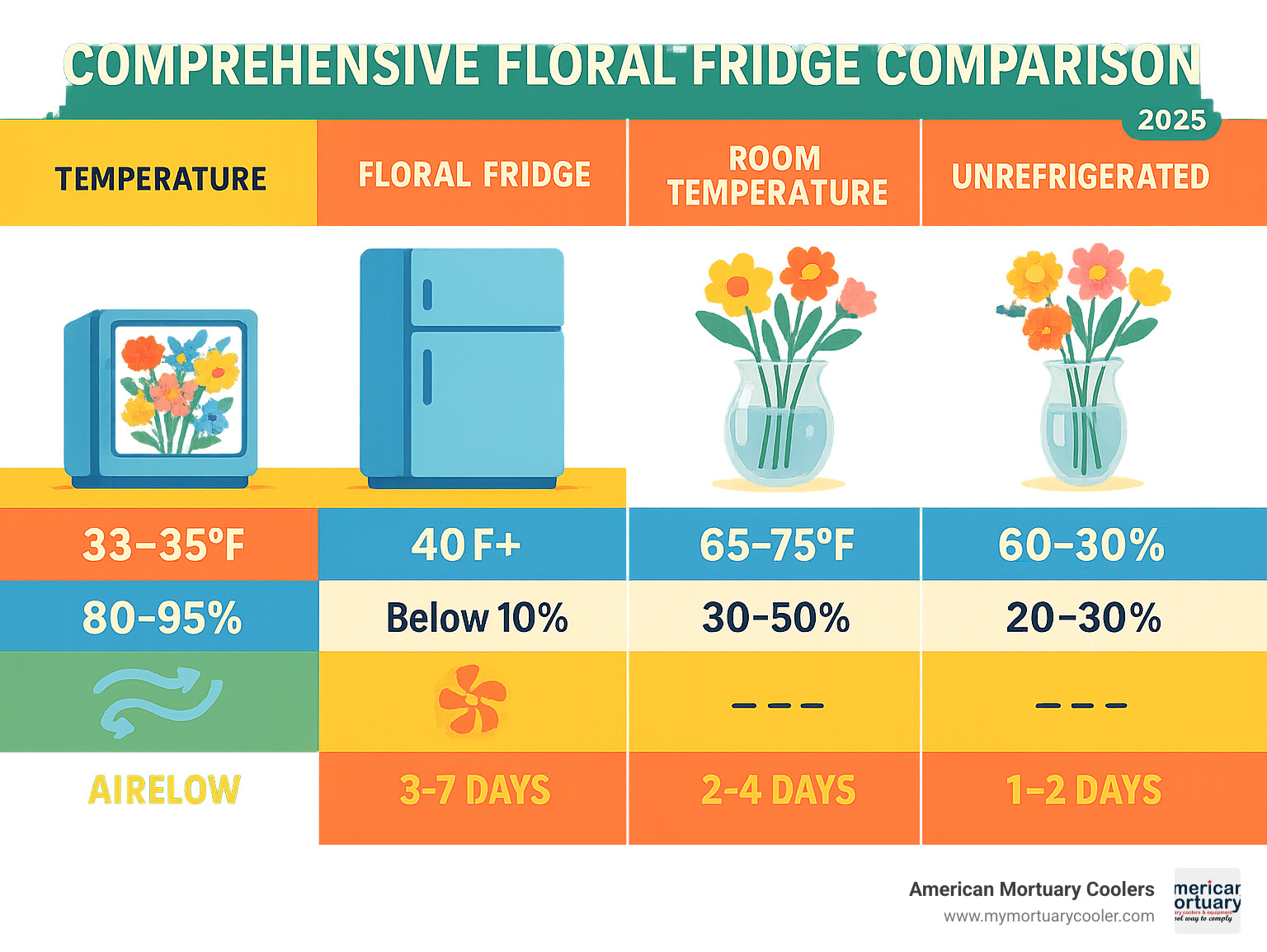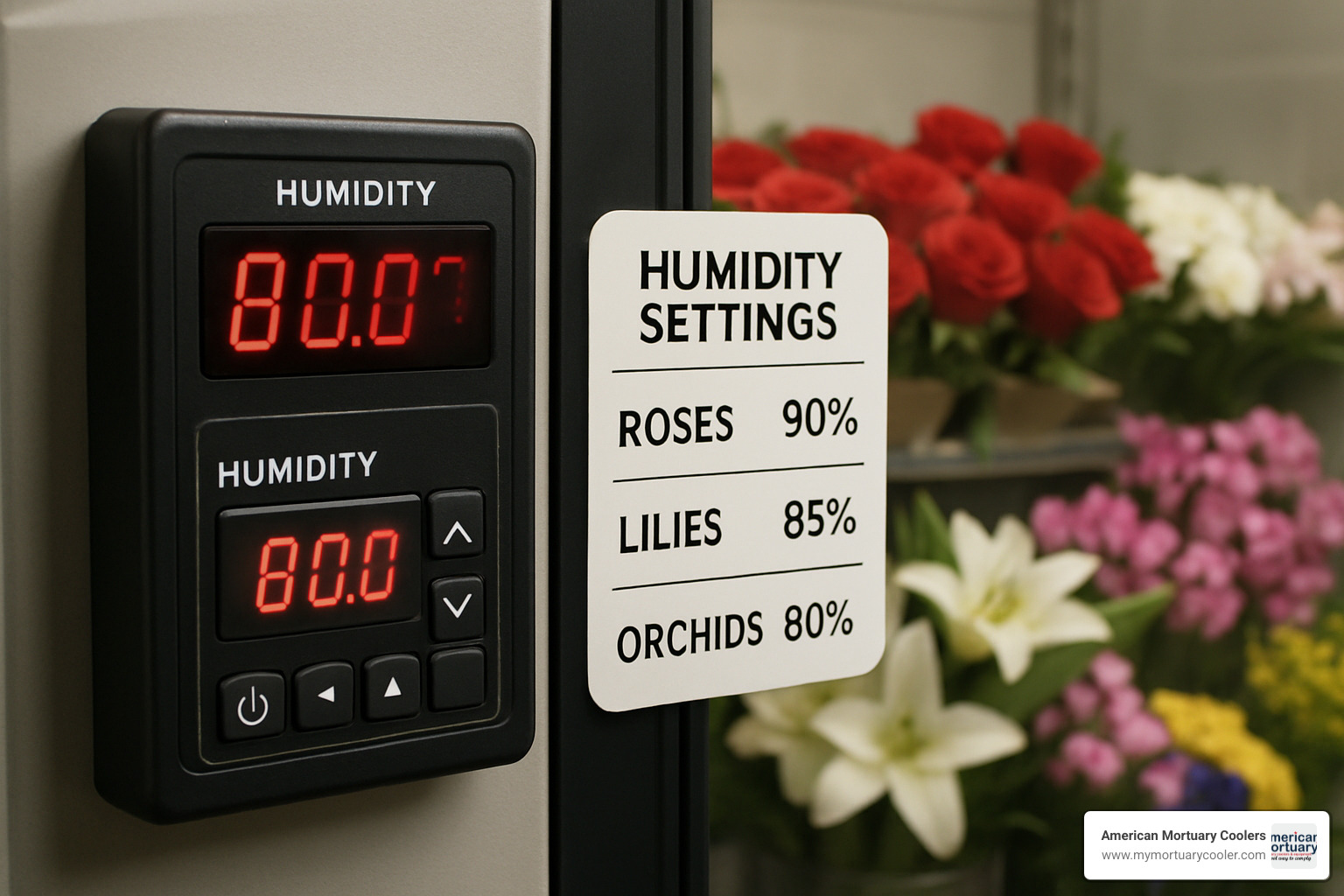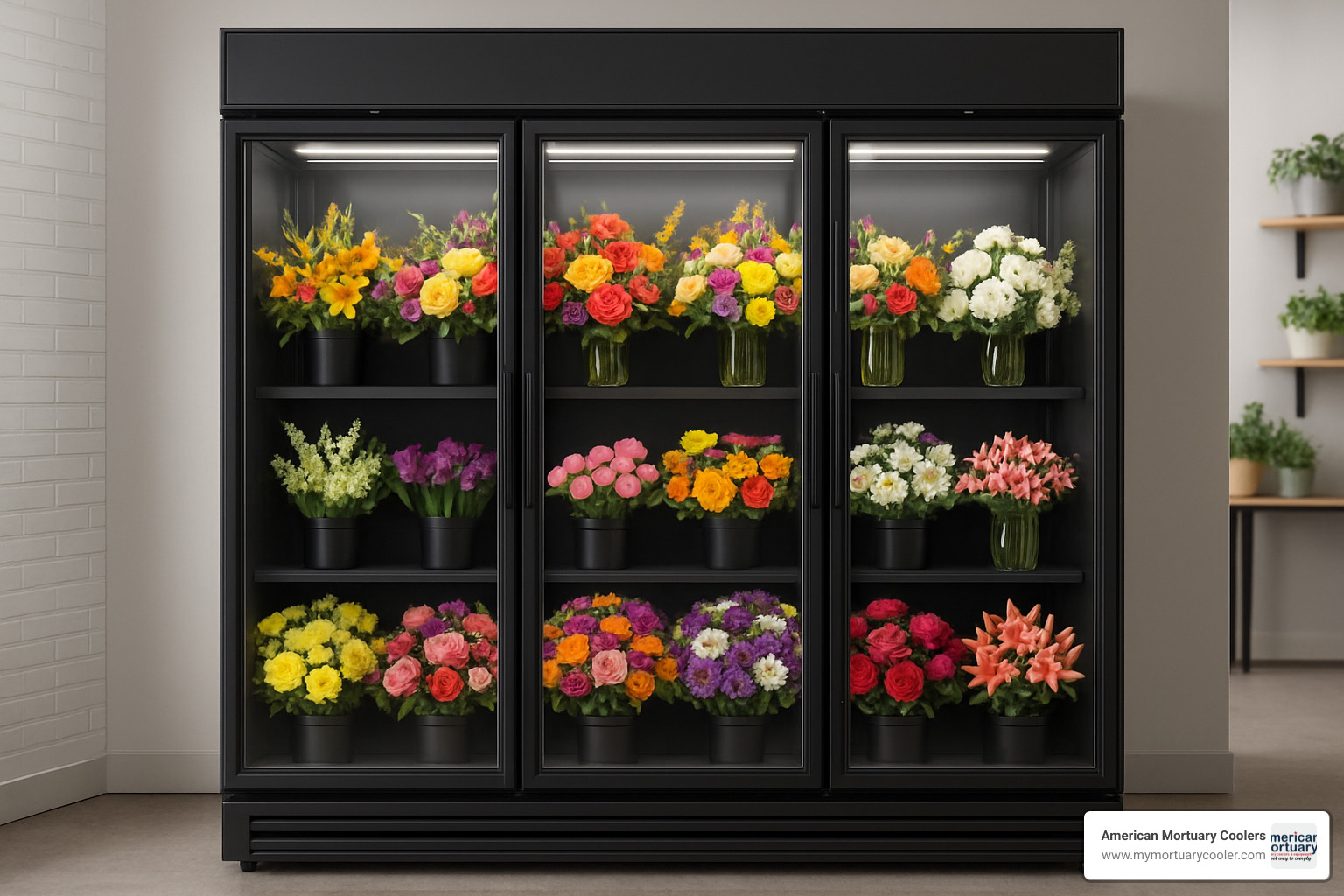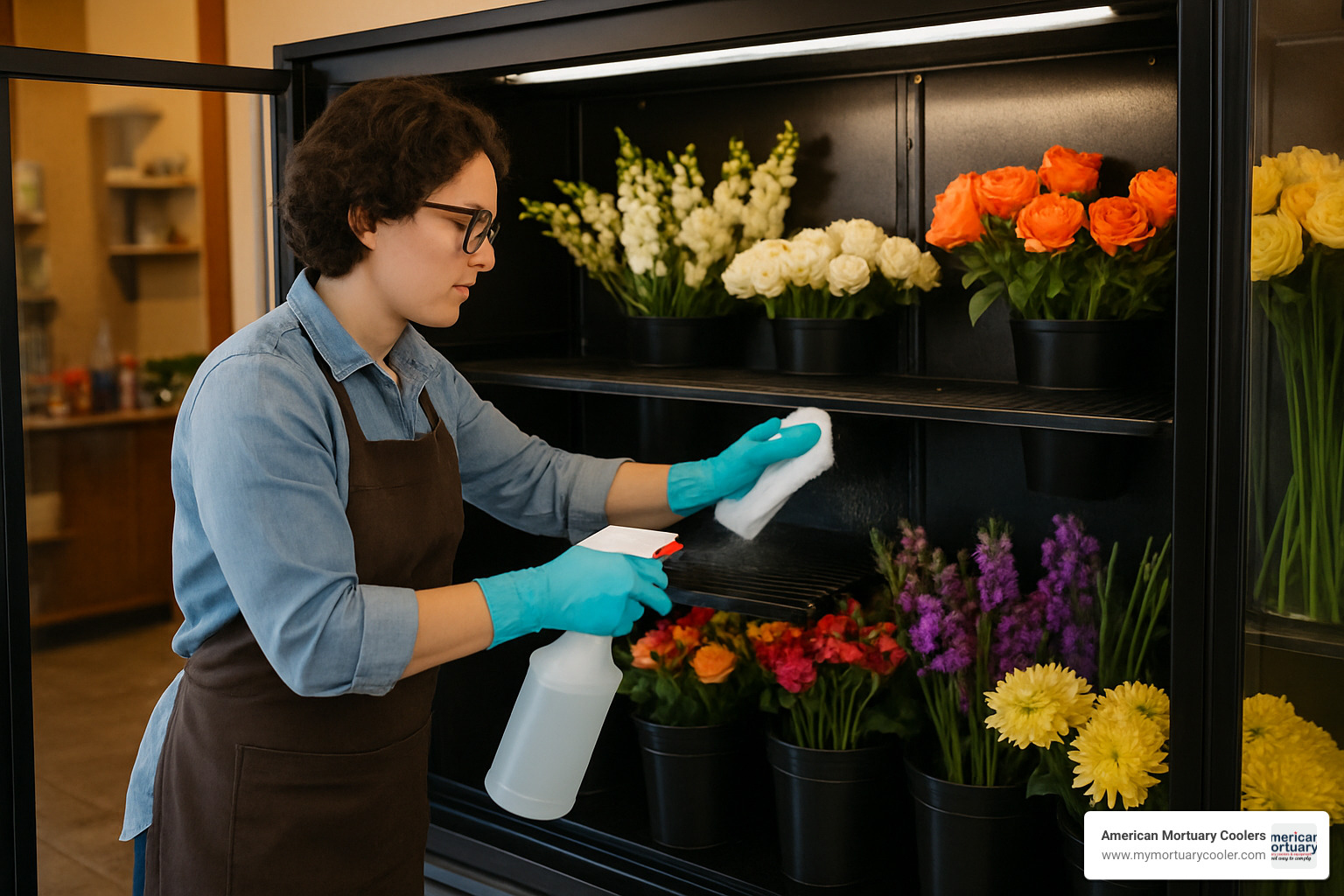Why Floral Fridges Are Essential for Flower Preservation
A floral fridge is a specialized refrigeration unit designed specifically to preserve cut flowers with precise temperature control (33-35°F), high humidity levels (80-95%), and gentle airflow systems that prevent dehydration and extend bloom life.
Quick Answer for Floral Fridge Buyers:
- Temperature: 33-35°F (compared to 40°F+ in regular fridges)
- Humidity: 80-95% (vs. below 10% in standard refrigerators)
- Airflow: Low-velocity, baffled circulation to prevent petal damage
- Key Features: Ethylene gas management, adjustable shelving, glass display doors
- ROI: Extends flower life 7-10+ days, reducing waste by up to 30%
The US cut flowers market is projected to reach $12.8 billion by 2028, yet many florists and funeral homes still struggle with premature wilting and inventory loss. As one florist finded, "flowers can be temperamental, and only a specialized floral fridge can keep them as refreshing as a spring morning."
Standard refrigerators simply don't work for flowers. They use rapid airflow that drops humidity below 10% when doors open frequently, causing petals to dehydrate and stems to wilt within days. Regular fridges also accumulate ethylene gas from food items, which accelerates flower aging.
Whether you're managing funeral arrangements, wedding bouquets, or retail displays, understanding the difference between a basic cooler and a purpose-built floral fridge can mean the difference between profit and waste.
I'm Mortuary Cooler, a national-level mortuary cooler supplier with extensive experience helping funeral homes and florists choose the right floral fridge solutions for their specific needs. My background in cold storage systems has shown me how proper refrigeration can transform a flower business's bottom line.

Handy floral fridge terms:
Floral Fridge Fundamentals – What Sets It Apart?
When you first hear "floral fridge," you might think it's just marketing fluff—after all, isn't cold just cold? But cut flowers need very specific conditions to slow their aging process gracefully.
Your regular refrigerator is designed to keep leftovers from spoiling. A floral fridge is designed to keep living tissue alive as long as possible. That's a completely different job.
Temperature precision comes first—while your kitchen fridge might swing between 35-40°F, flowers need that sweet spot of 33-35°F. Just a few degrees makes the difference between roses that last three days versus roses that stay gorgeous for over a week.
Humidity control is where things get really interesting. Your regular fridge keeps humidity below 10% to prevent mold on food. Flowers need 80-95% humidity, creating an environment where petals stay plump and vibrant instead of turning crispy.
Airflow in regular refrigerators blasts air around like a wind tunnel. That same airflow acts like a hair dryer on delicate petals. Floral fridges use gentle, baffled air systems that provide cooling without the hurricane effect.
Ethylene gas is basically kryptonite for flowers. Fruits and vegetables naturally produce this stuff, which tells flowers "time to age fast and die." A dedicated floral fridge eliminates this contamination completely.
| Feature | Floral Fridge | Beverage Cooler | Regular Refrigerator |
|---|---|---|---|
| Temperature Range | 33-35°F | 35-38°F | 35-40°F |
| Humidity Level | 80-95% | 60-70% | Below 10% |
| Airflow Type | Low-velocity, baffled | Medium velocity | High-velocity |
| Ethylene Control | Yes | No | No |
| Display Features | Glass doors, LED lighting | Glass doors | Solid/glass doors |
| Typical Use | Cut flowers, arrangements | Beverages, some food | Food storage |
According to research on the US cut-flower market, this industry is growing steadily—but only businesses that can maintain quality will capture that growth.
How a Floral Fridge Protects Your Investment
Every wilted rose, every droopy lily—that's cash walking out your door. A floral fridge isn't just about keeping flowers pretty; it's about protecting every dollar you've invested in inventory.
The real enemy is dehydration. Cut flowers are like marathon runners who can't drink water—they're still burning energy and losing moisture, but they can't replace what they're losing. Regular refrigerators actually speed up this dehydration process.
Floral fridges solve this with specialized high-humidity coils that maintain that crucial 80-95% humidity without creating condensation that could damage your blooms.
Let's say you've got $500 worth of roses in a regular fridge. You'll probably lose 30-40% to premature wilting within 3-4 days. Put those same roses in a proper floral fridge, and they'll stay sellable for 7-10 days. You've just doubled their lifespan.
Floral holding coolers also tackle bacterial growth, which is another silent killer of flower freshness. The precise temperature control slows down microbial reproduction, while controlled humidity prevents wet-dry cycles where bacteria multiply.
When you invest in a floral fridge, you're buying time. Time to sell your inventory, time to create stunning arrangements, and time to build a reputation for quality that keeps customers coming back.
Must-Have Technologies & Features in a Modern Floral Fridge
When you're shopping for a floral fridge, the technology inside makes all the difference between flowers that last days versus weeks. Today's units are like climate-controlled sanctuaries designed specifically for your blooms.
The humidity controls are probably the most important feature. Look for units with digital displays that show you exactly what's happening inside. The best floral fridge models use special high-humidity gravity coils instead of harsh evaporator fans that can suck the life out of your petals.
Baffled fan systems use clever deflectors to slow air movement down. Think of it like the difference between a gentle breeze and a hair dryer. Premium units reduce air velocity by up to 62% compared to standard refrigeration.
Surround-air systems create perfectly even conditions throughout your entire floral fridge. No more hot spots in the back or cold zones near the door—every flower gets the same treatment.

LED lighting serves double duty. You get crystal-clear visibility without the heat that old-style bulbs would pump into your carefully controlled environment. Many newer models even let you adjust the color temperature.
Double-pane insulated glass doors keep your cooling costs down while giving you a perfect view of everything inside. The heated frames prevent condensation that could drip on your arrangements.
Energy-efficient compressors have become standard in quality floral fridge units. Variable-speed models automatically adjust their power based on how hard they need to work.
Ethylene filtration systems tackle one of flowers' biggest enemies—that invisible gas that makes them age faster. Some units use activated carbon filters, while others have catalytic converters that break down ethylene molecules.
Smart sensor technology brings your floral fridge into the smartphone age. WiFi-enabled controllers can text you if something goes wrong, even when you're at home.
For technical details on insulation and energy efficiency, our guide on All About Insulated Coolers dives deep into the engineering. For the DIY crowd, there's latest research on DIY CoolBot builds, though we typically recommend professional-grade solutions.
Choosing Components for Your Floral Fridge
The inside of your floral fridge needs just as much thought as the cooling technology. Getting the right shelving and organization systems can literally double your storage capacity.
Wire shelving is your best friend because it lets air flow freely around your containers. Solid shelves create dead air pockets that mess with temperature control. You want wire shelving that's adjustable and built for commercial refrigeration.
Food-grade buckets are essential for water storage and conditioning stems. Regular plastic containers can leach chemicals into the water that your flowers will absorb. Food-grade non-toxic buckets give you safe, durable storage.
Think about flexibility when planning your floral fridge layout. You might have tiny bud vases one day and massive funeral arrangements the next. Adjustable shelving systems let you reconfigure everything as your needs change.
Smart Monitoring & Ethylene Management
Modern floral fridge management goes beyond just keeping things cold. The smartest operators use comprehensive monitoring and gas management systems to protect their investment around the clock.
WiFi alert systems are like having a security guard for your flowers. Systems like the CoolBot Pro connect to your smartphone and send instant alerts if temperatures drift outside your target range.
Ethylene management requires prevention and active removal. This invisible gas is produced naturally by some fruits and flowers, and it's like aging hormone for your blooms. Professional-grade ethylene absorbers use materials like potassium permanganate to neutralize this threat.
Temperature logging systems create detailed records that can save you thousands if you ever need to file an insurance claim or prove quality control for a big client.
Automated backup systems are your insurance policy against power outages and equipment failures. When you're dealing with perishable inventory worth hundreds or thousands of dollars, these backup systems quickly pay for themselves.
Sizing, Cost & ROI: Picking the Right Unit for Your Business
Choosing the right size floral fridge requires careful analysis of your current needs, growth projections, and space constraints. The decision between single-door units and larger installations can significantly impact both your initial investment and long-term profitability.
Single-door units work well for small florists or funeral homes with modest flower volumes. These compact units typically offer 20-25 cubic feet of storage and can handle daily arrangements for small operations. Prices generally range from $2,000-$4,000 for quality units.
Double-door models provide 40-50 cubic feet of storage and represent the sweet spot for many businesses. They offer sufficient capacity for moderate volumes while maintaining reasonable energy costs and space requirements.
Triple-door units and larger installations serve high-volume operations, wedding specialists, and funeral homes handling multiple services simultaneously. These units can store 75+ cubic feet of flowers and arrangements, with prices ranging from $8,000-$15,000 depending on features and construction quality.

Countertop models serve specialized needs like checkout displays or small arrangement storage. While limited in capacity, they can be cost-effective for specific applications and impulse sales.
Walk-in coolers represent the ultimate in floral storage capacity and flexibility. These custom-built solutions can accommodate virtually unlimited inventory and provide workspace for arrangement preparation. For businesses considering this option, our guide to Find Used Walk-In Floral Coolers Today offers valuable insights on cost-effective alternatives.
Cubic-foot guidelines suggest allowing 1.5-2 cubic feet per $100 of daily flower inventory. This accounts for arrangement containers, water buckets, and adequate air circulation space.
Energy costs vary significantly based on unit efficiency and local utility rates. Modern floral fridges typically consume 3-8 kWh per day, translating to $100-$300 annual operating costs in most markets.
Financing options make quality floral refrigeration accessible to businesses of all sizes. Many suppliers offer 0% financing programs, while equipment leasing can preserve cash flow for other business needs.
Refurbished units provide substantial savings for budget-conscious buyers. Quality refurbished floral fridges can cost 40-60% less than new units while providing reliable service when properly restored.
CoolBot DIY systems offer an alternative approach, using standard air conditioners with specialized controllers to create walk-in coolers at reduced costs. While these systems require more technical knowledge, they can provide significant savings for larger installations.
Payback period calculations should include reduced flower waste, extended inventory life, and improved customer satisfaction. Most businesses report payback periods of 12-24 months, with some high-volume operations achieving payback in under a year.
Waste reduction statistics show that proper floral refrigeration can reduce inventory loss by 25-40%, directly impacting profitability. A florist losing $200 monthly to premature wilting could save $2,400 annually with proper refrigeration.
Alternatives: Can a Regular Fridge Work?
The question of whether a regular refrigerator can substitute for a floral fridge comes up frequently, especially among budget-conscious businesses. While technically possible for short-term storage, the limitations quickly become apparent in commercial applications.
Pros of using regular refrigerators include lower initial cost, wider availability, and familiar operation. For emergency situations or very short-term storage (24-48 hours), a regular fridge can provide basic preservation.
Cons significantly outweigh the benefits for most applications. Regular refrigerators lack humidity control, use damaging high-velocity airflow, and often contain ethylene-producing foods that accelerate flower aging. The rapid humidity loss when doors open frequently can cause visible wilting within hours.
Short-term storage limitations become apparent quickly. While flowers might survive 1-2 days in a regular fridge, their quality degrades rapidly compared to proper floral refrigeration. Petals become brittle, stems lose turgidity, and overall appearance suffers.
Humidity loss represents the primary problem. Standard refrigerators can drop to below 10% humidity when doors open, while flowers need 80-95% humidity for optimal preservation. This dramatic difference explains why flowers stored in regular fridges often look tired and wilted even when kept cold.
Ethylene exposure from stored fruits and vegetables can reduce flower life by 50% or more. Even small amounts of ethylene gas trigger senescence responses in sensitive flowers like roses and carnations.
For detailed analysis of this topic, Can You Use a Regular Refrigerator for Flowers? provides comprehensive coverage of the limitations and potential solutions.
The bottom line: while regular refrigerators might work for occasional home use, businesses serious about flower quality and profitability need dedicated floral fridge solutions.
Best Practices for Preparing, Storing & Maintaining Flowers in a Floral Fridge
Getting the most from your floral fridge isn't just about plugging it in and hoping for the best. Success comes from understanding what your flowers need and creating the right environment for them to thrive.
Stem conditioning is where the magic begins. Cut each stem at a sharp 45-degree angle while holding it under cool running water. This prevents air bubbles from blocking the stem's ability to drink water. Strip away any leaves that would sit below the waterline—those submerged leaves become breeding grounds for bacteria.
Temperature tweaks might be needed depending on what you're storing. While your floral fridge should generally run at 33-35°F, some flowers are pickier. Tropical beauties like orchids prefer to stay warmer around 50-55°F. Hardy flowers like chrysanthemums are perfectly happy at the cooler end.
Daily check-ins with your flowers are essential. Take a quick walk through your cooler, looking for signs of wilting, brown spots, or drooping. Check water levels and give your temperature display a glance to make sure everything's running smoothly.

Keeping things clean separates the pros from the amateurs. Set up a weekly routine where you wipe down all interior surfaces, clean your shelving, and refresh water containers.
Monthly deep cleaning sessions should tackle the coils, fans, and drainage systems. These components work hard to maintain that perfect environment and deserve TLC to keep performing their best.
Sanitizer selection matters. Stick with food-safe products that won't harm your flowers or leave residues. Quaternary ammonium compounds work well for regular cleaning, while hydrogen peroxide solutions provide thorough sanitization.
Door gaskets are the unsung heroes of temperature control. These rubber seals prevent warm air from sneaking into your cooler. Clean them weekly with mild soap and water, and watch for cracks or tears that could compromise your environment.
Airflow management requires strategy. Leave about 1-2 inches between containers and walls—flowers need breathing room. Avoid cramming every available space full of inventory. Overcrowding restricts air circulation and creates hot spots.

Roses deserve special attention because they're both popular and particular. Keep them at 33-34°F with humidity cranked up to 90-95%. These romantic favorites are especially sensitive to ethylene gas, so consider giving them their own space away from other flower types.
Tropical flowers often prefer warmer conditions and may need separate temperature zones or dedicated units. Cold damage below 50°F can turn these exotic beauties into expensive disappointments.
Humidity fine-tuning depends on your location. If you're in a desert climate, you might need to push humidity levels higher to compensate for dry air that sneaks in when doors open. In naturally humid areas, you might run slightly lower levels to prevent condensation issues.
The key to success is understanding that each flower type has its preferences. Pay attention to how different varieties respond to your storage conditions, and don't be afraid to make small adjustments based on what you observe.
For more detailed guidance on storage techniques for different flower types, check out our comprehensive guide on floral holding coolers.
Frequently Asked Questions about Floral Fridges
When it comes to floral fridge storage, we hear the same questions from florists and funeral directors across the country. Let me share the answers that will help you get the most from your flower preservation investment.
Can I store all flower types in a floral fridge?
Here's the honest truth: most cut flowers absolutely love floral fridge conditions, but Mother Nature created some picky varieties that need special treatment.
Hardy flowers are your best friends in standard floral refrigeration. Roses, carnations, chrysanthemums, and lilies practically sing with joy at 33-35°F temperatures and that lovely 80-95% humidity. These workhorses of the flower world will reward you with extended freshness that keeps customers happy and your profit margins healthy.
Tropical flowers, however, are the divas of the flower world. Orchids, bird of paradise, and other exotic beauties prefer their own VIP treatment at warmer temperatures around 50-55°F. Think of them as flowers that never forgot their warm island homes—they'll actually suffer cold damage if you try to chill them in standard floral fridge conditions.
Some flowers simply refuse refrigeration altogether. Cold-sensitive varieties like impatiens and begonias will throw a tantrum if you try to refrigerate them, suffering cellular damage that no amount of TLC can fix. These flowers prefer room temperature storage and gentle care.
The key is knowing your flowers and respecting their individual needs. When in doubt, start with standard conditions and watch how your blooms respond.
What temperature & humidity should I set for my floral fridge?
After years of helping funeral homes and florists optimize their flower storage, I've learned that the magic numbers are 34°F and 90% humidity for most applications. These settings create that sweet spot where flowers slow down their aging process without suffering cold stress.
Start with these baseline settings and fine-tune based on what you're seeing. Your flowers will tell you if they're happy—crisp petals, strong stems, and vibrant colors mean you've hit the mark. Wilting, browning, or brittle petals suggest it's time for adjustments.
Different flowers have their preferences, just like people. Roses love it slightly cooler at 33-34°F with maximum humidity around 90-95%. They're tough customers that appreciate the chill. Tropical flowers, on the other hand, need that warmer 50-55°F range with humidity around 85-90%. Hardy perennials fall somewhere in the middle at 33-35°F with 80-90% humidity.
Make changes gradually—your floral fridge isn't a race car, and sudden adjustments can shock your flowers. Move temperatures by one degree at a time and give your blooms a day or two to adjust before making further changes.
How often should I clean and sanitize the unit?
Think of your floral fridge like a high-performance vehicle—regular maintenance keeps it running smoothly and protects your valuable cargo. Here's the cleaning schedule that works for busy professionals:
Every single day, take five minutes to check water levels, remove any flowers that have seen better days, and wipe up spills. It's like brushing your teeth—small daily habits prevent big problems later.
Weekly cleaning is your deep-care routine. Clean all interior surfaces with food-safe sanitizer, wash and refill those water containers, and give the door gaskets a good inspection. Clean gaskets seal properly, keeping your carefully controlled environment from leaking away.
Monthly maintenance goes deeper into the system. This is when you clean the coils and fans, sanitize drainage systems, and check that everything's running at peak performance. It's also a great time to verify that your temperature and humidity readings are accurate.
Quarterly professional maintenance is like an annual physical for your floral fridge. A qualified technician can spot potential problems before they become expensive repairs, calibrate your systems, and replace filters or worn components.
A clean floral fridge isn't just about appearance—it's about preventing bacterial growth that can destroy your flower investment overnight. Regular maintenance also extends your equipment's life, protecting the investment you've made in proper floral preservation.
Conclusion & Next Steps
Investing in the right floral fridge isn't just about keeping flowers cold—it's about changing how your business operates. Every wilted rose represents lost profit, disappointed customers, and missed opportunities. The right refrigeration system changes that equation completely.
Specialized floral refrigeration pays for itself through reduced waste, extended inventory life, and happier customers who keep coming back. Those precise temperature controls, humidity management systems, and gentle airflow features aren't fancy extras—they're the foundation of a profitable flower business.
At American Mortuary Coolers, we've spent years helping funeral homes and businesses across Tennessee and beyond solve their cold storage challenges. Our experience with custom mortuary coolers has taught us that durable, custom solutions always deliver better long-term value than quick fixes or generic equipment.
The same principle applies to floral fridge selection. Whether you're running a small funeral home in Johnson City or managing a busy floral operation serving customers across the Southeast, matching your refrigeration to your specific needs makes all the difference.
Think about your daily flower volume, available space, and growth plans. A compact single-door unit might be perfect for occasional arrangements, while high-volume operations benefit from walk-in coolers that provide both storage and workspace. The investment scales with your needs, but the principle remains constant: freshness equals profit.
We've seen too many businesses struggle with inadequate refrigeration, watching their beautiful arrangements lose their appeal before they can reach customers. Don't let poor storage limit your potential or compromise the comfort and joy your flowers bring to people during important moments.
From Atlanta to Los Angeles, Chicago to Dallas, we deliver quality cooling solutions directly to businesses that understand the value of proper preservation. The flower industry continues growing, creating opportunities for businesses equipped with the right technology.
Your flowers deserve preservation technology that maintains their natural beauty. Your customers deserve arrangements that stay fresh and vibrant. Your business deserves the profitability that comes from minimizing waste and maximizing quality. The right floral fridge makes all three possible.
For businesses considering broader cold storage solutions, our comprehensive guide on American Walk-In Coolers: Essential Solutions for Efficient Cold Storage Across Industries provides valuable insights across multiple applications.
Ready to protect your flower investment? We're here to help you steer the options and find the perfect floral fridge solution for your unique needs. After all, every day you extend flower life is another day of profit in your pocket.
















